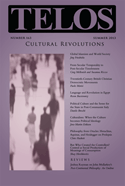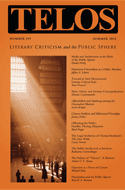By Jörg Friedrichs · Thursday, August 8, 2013 Jörg Friedrichs’s “Global Islamism and World Society” appears in Telos 163 (Summer 2013). Read the full version online at the Telos Online website, or purchase a print copy of the issue in our store.
 The piece is an eye-opener on contestation between global Islamism and cosmopolitan world society. It develops a comprehensive understanding of the former as the communitarian mirror image of the latter. Global Islamism and cosmopolitan world society are presented as varieties of globalization. The objective is to understand global Islamism as a political project and to assess its chances of successfully competing against cosmopolitan world society. This is accomplished by a comparative assessment of the degree to which either of them can achieve social integration, which is a prerequisite for the success of any political project. World society thrives on established forms of political and legal integration, and is buttressed by integration via functional subsystems. Global Islamism relies on the expectation of strong communal engagement and the unapologetic exclusion of dissidents and outsiders. It turns out that global Islamism’s bolder discriminatory practices are a two-edged sword because they also lead to internal divisions, and that global Islamism is not stronger than world society with regard to sociability. Insofar as the integration of Muslims into a universal community of believers is even more utopian than the realization of cosmopolitan world society, global Islamism is at a serious competitive disadvantage and thus bound to be frustrated. Until that happens, conflict between global Islamism and world society will continue to pose significant challenges. It is hoped that these challenges may be better managed when both are recognized as rival globalization projects, and when their mutual incompatibilities are acknowledged. The piece is an eye-opener on contestation between global Islamism and cosmopolitan world society. It develops a comprehensive understanding of the former as the communitarian mirror image of the latter. Global Islamism and cosmopolitan world society are presented as varieties of globalization. The objective is to understand global Islamism as a political project and to assess its chances of successfully competing against cosmopolitan world society. This is accomplished by a comparative assessment of the degree to which either of them can achieve social integration, which is a prerequisite for the success of any political project. World society thrives on established forms of political and legal integration, and is buttressed by integration via functional subsystems. Global Islamism relies on the expectation of strong communal engagement and the unapologetic exclusion of dissidents and outsiders. It turns out that global Islamism’s bolder discriminatory practices are a two-edged sword because they also lead to internal divisions, and that global Islamism is not stronger than world society with regard to sociability. Insofar as the integration of Muslims into a universal community of believers is even more utopian than the realization of cosmopolitan world society, global Islamism is at a serious competitive disadvantage and thus bound to be frustrated. Until that happens, conflict between global Islamism and world society will continue to pose significant challenges. It is hoped that these challenges may be better managed when both are recognized as rival globalization projects, and when their mutual incompatibilities are acknowledged.
Continue reading →
By Russell A. Berman · Monday, June 24, 2013 Telos 163 (Summer 2013) is now available for purchase in our store.
 Profound change in society may involve shifting control of political power, the character of economic systems, or access to resources, but it can also have to do with the structures of meaning we bundle together in various understandings of culture. This issue of Telos looks at the explosive forces located specifically in the intangible dimensions of culture and how they may play out in revolutionary or counter-revolutionary processes. Profound change in society may involve shifting control of political power, the character of economic systems, or access to resources, but it can also have to do with the structures of meaning we bundle together in various understandings of culture. This issue of Telos looks at the explosive forces located specifically in the intangible dimensions of culture and how they may play out in revolutionary or counter-revolutionary processes.
Continue reading →
By Daniel Purdy · Monday, July 9, 2012 Daniel Purdy’s “Media and Architecture at the Birth of the Public Sphere” appears in Telos 159 (Summer 2012). Read the full version online at the Telos Online website, or purchase a print copy of the issue here.
 This article examines the policy discussion surrounding the concept of “the European city.” This innocuous phrase has become a source of considerable concern among urban planners, architects, and sociologists because “the European city” is consistently described as under siege by the economics of globalization and new media technology. At stake is an idealized experience of urbanity that is closely associated with the history of European civilization, the emergence of liberal democracy, personal freedoms, and the market economy as a localized exchange that could be regulated by the state. Despite these modern connotations, the ideal type of this European city is medieval, wherein well-preserved historic buildings are aligned along irregular streets open only to pedestrians. The type of building that today is considered typical of the European city predates the Enlightenment and most certainly has little in common with industrialization. This article examines the policy discussion surrounding the concept of “the European city.” This innocuous phrase has become a source of considerable concern among urban planners, architects, and sociologists because “the European city” is consistently described as under siege by the economics of globalization and new media technology. At stake is an idealized experience of urbanity that is closely associated with the history of European civilization, the emergence of liberal democracy, personal freedoms, and the market economy as a localized exchange that could be regulated by the state. Despite these modern connotations, the ideal type of this European city is medieval, wherein well-preserved historic buildings are aligned along irregular streets open only to pedestrians. The type of building that today is considered typical of the European city predates the Enlightenment and most certainly has little in common with industrialization.
The notion of the “European city” has a two-faced relation to globalization: on the one hand, the many economic, political and cultural relations that join cities together into the European market system constitute one of the large-scale networks of the global economy that historians can trace back to the height of the Middle Ages; on the other, the term is invoked today in order to draw a boundary and insist on a distinction so as to preserve a quality that is considered fundamentally European. This distinctly urban character is associated with public spaces that foster democratic institutions. Since the Middle Ages, the argument runs, European cities have been designed to preserve openly accessible forums for democratic politics and capitalist exchange. The preservation of European democracy is therefore often correlated with the maintenance of these urban places. I argue that the successful use of urban centers for politics and exchanges always also depends on the existence of small isolated spaces cut off from the general population. For urban public spaces to accomplish their political and economic ends, they have always required their antithesis, the exclusive private room. Nowhere is this juxtaposition more important than in the Enlightenment institution of the public sphere.
Continue reading →
|
|
 The piece is an eye-opener on contestation between global Islamism and cosmopolitan world society. It develops a comprehensive understanding of the former as the communitarian mirror image of the latter. Global Islamism and cosmopolitan world society are presented as varieties of globalization. The objective is to understand global Islamism as a political project and to assess its chances of successfully competing against cosmopolitan world society. This is accomplished by a comparative assessment of the degree to which either of them can achieve social integration, which is a prerequisite for the success of any political project. World society thrives on established forms of political and legal integration, and is buttressed by integration via functional subsystems. Global Islamism relies on the expectation of strong communal engagement and the unapologetic exclusion of dissidents and outsiders. It turns out that global Islamism’s bolder discriminatory practices are a two-edged sword because they also lead to internal divisions, and that global Islamism is not stronger than world society with regard to sociability. Insofar as the integration of Muslims into a universal community of believers is even more utopian than the realization of cosmopolitan world society, global Islamism is at a serious competitive disadvantage and thus bound to be frustrated. Until that happens, conflict between global Islamism and world society will continue to pose significant challenges. It is hoped that these challenges may be better managed when both are recognized as rival globalization projects, and when their mutual incompatibilities are acknowledged.
The piece is an eye-opener on contestation between global Islamism and cosmopolitan world society. It develops a comprehensive understanding of the former as the communitarian mirror image of the latter. Global Islamism and cosmopolitan world society are presented as varieties of globalization. The objective is to understand global Islamism as a political project and to assess its chances of successfully competing against cosmopolitan world society. This is accomplished by a comparative assessment of the degree to which either of them can achieve social integration, which is a prerequisite for the success of any political project. World society thrives on established forms of political and legal integration, and is buttressed by integration via functional subsystems. Global Islamism relies on the expectation of strong communal engagement and the unapologetic exclusion of dissidents and outsiders. It turns out that global Islamism’s bolder discriminatory practices are a two-edged sword because they also lead to internal divisions, and that global Islamism is not stronger than world society with regard to sociability. Insofar as the integration of Muslims into a universal community of believers is even more utopian than the realization of cosmopolitan world society, global Islamism is at a serious competitive disadvantage and thus bound to be frustrated. Until that happens, conflict between global Islamism and world society will continue to pose significant challenges. It is hoped that these challenges may be better managed when both are recognized as rival globalization projects, and when their mutual incompatibilities are acknowledged.  This article examines the policy discussion surrounding the concept of “the European city.” This innocuous phrase has become a source of considerable concern among urban planners, architects, and sociologists because “the European city” is consistently described as under siege by the economics of globalization and new media technology. At stake is an idealized experience of urbanity that is closely associated with the history of European civilization, the emergence of liberal democracy, personal freedoms, and the market economy as a localized exchange that could be regulated by the state. Despite these modern connotations, the ideal type of this European city is medieval, wherein well-preserved historic buildings are aligned along irregular streets open only to pedestrians. The type of building that today is considered typical of the European city predates the Enlightenment and most certainly has little in common with industrialization.
This article examines the policy discussion surrounding the concept of “the European city.” This innocuous phrase has become a source of considerable concern among urban planners, architects, and sociologists because “the European city” is consistently described as under siege by the economics of globalization and new media technology. At stake is an idealized experience of urbanity that is closely associated with the history of European civilization, the emergence of liberal democracy, personal freedoms, and the market economy as a localized exchange that could be regulated by the state. Despite these modern connotations, the ideal type of this European city is medieval, wherein well-preserved historic buildings are aligned along irregular streets open only to pedestrians. The type of building that today is considered typical of the European city predates the Enlightenment and most certainly has little in common with industrialization. 

